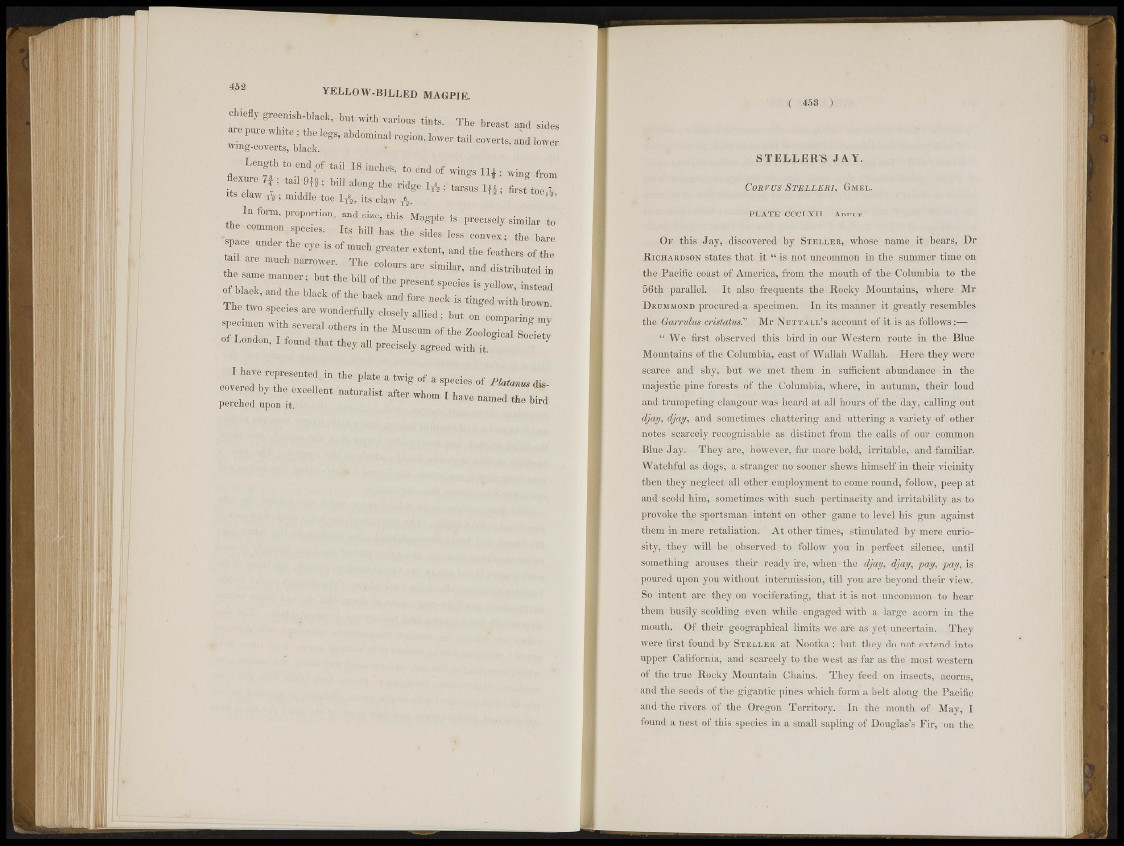
452
YELLOW-BILLED MAGPIE.
oMe% greenishfblaRkji>bTit-iwth ^ i o n * tints, ^ e breast, and safer
MMtfaia',« g i j y , J j , ^ g M lower
^ n g t h t„ end^ t ax l l g to i e n d ^ ^
• • • • MH a l 0 n g t ] l e i i d golA ; t eLi saiS its rfMo.toe its' claw , .,.
the common ^species; Its bit i a s . thB ^ l e s i o n J , ftelr — • BS m am • ¡¡Sgil
fefetirilijifjh'ta - • and distributed in
I manner, Imt the b i l l E I M I M — i 1 — ¡n s l l .H,,
The t w „ species a ^wo n d e rMy ^ s e ^ a l l i e d ; but, o n , T O m B m m ^ H
of London, I found that they all precisely agreed with itZI
h ^ p r e S « e d t i n Opiat e species,If m
f 458 : )
S T E L L E R ' S JAY.
Cos r us STELLE RI, GMEL.
P L A T E CCCLXII. ADULT.
O F this JayJ discovered by ST ELLE R, whose name it bears, Dr
RICHARDSON states that it " is not uncommon in the summer time on
the Pacific coast of America, from the mouth of the Columbia to the
56th parallel. It also frequents the Rocky Mountains, where Mr
DRUMMOND procured a specimen. In its manner it greatly resembles
the Garrulus crist&tusf*. Mr NUTTÀLL'S account of it is as foUows£|r^;
C£ We first observed this bird in Our Western route in the Blue
Mountains of the Columbia, east of Wallah Wallah. Here they Were
scarce and shy, but we met them in sufficient abundance in the
majestic pine forests of the Columbia, where, in autumn, their loud
and trumpeting clangour was heard at all hours of the day, calling out
djay, djay, and sometimes chattering and uttering a variety of other
notes scarcely recognisable as distinct from the calls of our common
Blue Jay. They are, however, far more bold, irritable, and familiar.
Watchful as dogs, a stranger no sooner shews himself in their vicinity
then they neglect all other employment to come round, follow, peep at
and scold him, sometimes with such pertinacity and irritability as to
provoke the sportsman intent on other game to level his gun against
them in mere retaliation. At other'times, stimulated by mere curiosity,
they will be observed to follow you in perfect silence, until
something arouses their ready ire, when the djay, djay, pay, pay, is
poured upon you without intermission, till you are beyond their view.
So intent are they on vociferating, that it is not uncommon to hear
them busily scolding even while engaged with a large acom in the
mouth. Of their geographical limits we are as yet uncertain. They
were first found by STELLER at Nootka ; but they do not extend into
upper California, and scarcely to the west as far as the most western
of the true Rocky Mountain Chains. They feed on insects, acorns,
and the seeds of the gigantic pines which form a belt along the Pacific
and the rivers of the Oregon Territory. In the month of May, I
found a nest of this species in a small sapling of Douglas's Fir, on the.